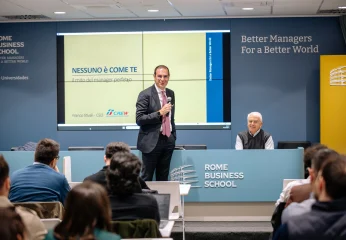Rome Business School study: the counterfeiting market is growing in Italy. There are 4 counterfeit works of art sold per day in the 5th country in the world by value on the black market.

- In Italy, 4 counterfeit works of art are sold every day, 1,547 in 2020 against 1,083 in 2019, with an estimated percentage of counterfeit works in circulation of 45%;
- Globally, Italy is one of the countries whose companies are most affected by counterfeiting and the fifth country in the world for the total value of the black market;
- Between 2008 and 2019 184.9 thousand seizures were carried out in Italy for counterfeiting, with approximately 569 million items seized with an estimated value of over 5.8 billion euros;
- 48% of the national total of seizures is concentrated in Lombardy (30.3%) and Lazio (17.6%);
- Counterfeit products generate more than $ 250 billion a year in profits for organized crime worldwide, in Italy the earnings of organized crime in the last year alone amounted to at least 2.5 billion, of which at least 225 million are borne of Italian companies;
- Unemployment among the economic damages: from 2022 the legitimate jobs endangered in the world will be about 5.4 million.
Rome, 7 December 2021. Rome Business School, part of the Formación y Universidades network created in 2003 by De Agostini and the Planeta Group, has published the study: “Counterfeiting in Italy. Fashion and art: two pillars of Made in Italy threatened by the fake market “. The research, curated by Valerio Mancini, Director of the Research Center of the Rome Business School in collaboration with Fabio Guglietta, CEO of BiT256 and the professors of the Rome Business School Giosuè J. Prezioso, (Law and Economics of Cultural Industries) and Michela Bonafoni, (Cultural Advisor and Program Director of the Master in Fashion & Design Management), studies the main characteristics of the crime of counterfeiting, the sectors most affected and the international legal tools available to combat this illegal activity in Italy.
Counterfeiting falls within the category of criminal phenomena of a transnational nature, but there is a general tendency to underestimate the seriousness and gravity of this crime despite the fact that it is in strong growth, weakens the Italian workforce and has a strong impact on the economy. : according to a study by the EUIPO (European Union Intellectual Property Office) and EPO (European Patent Office), in Italy one job in 3 (about 31.5%) is found in industries that make intensive use of trademarks and patents, contributing to half of the Italian GDP.
This illicit activity has a significant negative effect on the economy of the countries concerned and on the companies that are affected by it. Already in 2008, the OECD estimated a reduction in corporate profits of € 2.9 billion per year and losses of over 100,000 jobs in Italy alone. The International AntiCounterfeiting Coalition (IACC, 2010) has estimated the magnitude of the phenomenon: the counterfeiting market revolves around 10% of world trade, the largest producers are in Asia (Hong Kong, China, Turkey), while among consumers the first it is Europe (especially Italy, Spain, Turkey).
Italy is among the top producers and consumers of counterfeit products
According to the estimate of Illicit Trade (2020), Italy is the fifth country in the world for the total value of the black market and is also one of the European states most affected by the phenomenon of counterfeiting both as a producing country and as a consumer country.
The most exposed sector is that of clothing, with a production value of 2.2 billion euros, equal to 32.5% of the total. Followed by the audiovisual sector, with almost 2 billion euros (28.5% of the total), electrical equipment and IT products with 1 billion euros, food products also with one billion euros.
The most popular product categories in 2019 by counterfeiters are clothing accessories, with an increase of + 48% compared to the previous year. In particular, bags and leather goods are the goods in first place among imported counterfeit goods: 16% of the goods imported into Italy in this category are fake products. This is followed by electrical and IT equipment, with an increase of over 90%, and footwear with + 307% compared to the previous year.
In the last year alone, even if in full pandemic, in Italy, counterfeit products have guaranteed organized crime earnings of at least 2.5 billion, of which at least 225 million are borne by Italian companies. The Camorra is undoubtedly the most dynamic and active organization, having already diversified the areas of criminal action for years (counterfeiting of goods together with money laundering, arms and drug trafficking). This is also active abroad, through the control of commercial activities – which it camouflages in entrepreneurial activities – and creating a complex economic-financial network in Italy and other countries, especially in Western Europe, the United States, Brazil, Canada and Australia. Clans belonging to the Calabrian ‘Ndrangheta and the Salento underworld are not unrelated to the counterfeiting of trademarks.
Globally, counterfeit products generate more than $ 250 billion a year in profits for organized crime. Among the countries whose companies are most affected by this crime, the United States, France, Switzerland, Germany, Japan and Korea stand out. Furthermore, we must consider the economic damage produced by the fake market, with the resulting unemployment: according to the International Chamber of Commerce, in fact, it is estimated that by 2022 the legitimate jobs put at risk will be about 5.4 million, and the damage to the image of the brands towards their target audience.
As for the seizures, on the other hand, according to the IPERICO 2021 Report, between 2008 and 2019 the Customs and Monopoly Agency and the Guardia di Finanza carried out 184.9 thousand seizures for counterfeiting in Italy, with about 569 million pieces. seized (excluding food, alcoholic beverages, medicines and tobacco) with an estimated value of over 5.8 billion euros, a serious damage to the real producers, companies, brands and patent holders.
A regional analysis
The main hubs for criminal activities related to counterfeiting are represented by Lombardy, Campania, Lazio and Liguria. The data on the 12,422 seizures for counterfeiting show a concentration of interventions in the Lombardy and Lazio regions in 2019, the scene of 48% of the national total of seizures. Lombardy, in first place with 3,765 seizures (30.3% of annual national seizures), in 2019 recorded an increase of + 34.7% compared to 2018. In the area of Milan (53%) and Bergamo (22%) 75% of the Lombard seizures were carried out.
Lazio records 17.6% of 2019 seizures with 2,181 seizures (-22% compared to 2018), demonstrating that the capital with its vast metropolitan area and enormous tourist flow continues to represent a relevant market for the sale of products counterfeit. Campania is in third place with 1,098 seizures, 8.8% of 2019 seizures (-6.6% compared to 2018), and is followed by Puglia and Tuscany.
At a global level, however, the research shows that the countries of origin of the seized goods are concentrated in Asia (83.29%), in particular Hong Kong (46.4%), China (27.3%) and Turkey (10%). ). The main sectors involved are apparel (29%), apparel accessories (19%), footwear (16%) and electrical equipment from Hong Kong; clothing accessories (32%), watches and jewelry (29%) and clothing (9%) from China; clothing (34%), clothing accessories (31%) and footwear (24%) from Turkey.
In Italy, more locally, the “fakes” are mainly made in Campania (clothing and commodities), Tuscany, Lazio and Marche (leather products), in the North-East and North-West regions (watches), but between the fake products also find pieces of art of international fame and quality.
Counterfeiting in the art markets and Made in Italy
A recent OECD study (April 2021) quantified the capital generated by the counterfeiting of ‘Made in Italy’ products at over 30 billion euros; however, the study focuses on mass-commercial goods – including clothing, products electronic and optical, food and pharmaceuticals – art, as a category, is not counted, but is still growing strongly: only in 2020 the ‘Nucleo Carabinieri for the Protection of Italian Cultural Heritage’ – the defense body against these and others fraudulent practices – it seized 1,547 forgeries, compared to 1,083 in 2019: on average 4 per day. Of these, 87% belongs to the contemporary art segment, while the remainder concerns assets from other eras and archaeological finds.
Although the data are alarming, what makes them even more serious is the specter of the continuous entry of new media involved: the boom in the seizure of sculptures stands out, which has gone from 146 units in 2019 to 7,460 in 2020. Today, after weapons and drugs, the black art market is in fact the third most profitable criminal industry: the estimated average percentage of counterfeit works in circulation is 45%.
What tools to tackle and stop counterfeiting?
In recent years, multiple tools and methods have been developed to recognize and track products attributable to three macro categories: track-and-trace technologies; devices not visible to the naked eye and perceptible only by employees (covert technologies); the most obvious solutions also perceivable by customers (overt technologies). However, there is a double trade-off: one between the sophistication level of the anti-counterfeiting tool and the cost for its implementation and one between the effectiveness of the solution and the perception of it by customers (both inversely proportional). For this reason, the authors of the research argue that there are currently no tools that are not easily copied and that the best solution to protect products is a combination of track-and-trace, overt and covert solutions.
There are also other innovative tools, such as the one developed by the spin-off of the Ca ‘Foscari University of Venice, Aries: DNArt. This technology inserts an invisible and unreproducible code into works of art, without damaging them, and can be “read” at any time by special software. A second example is the ‘blockchain’ technology, to which many brands linked to the Made in Italy fashion sector have already joined during the pandemic by creating the “blockchain consortium”, in which the consent process is controlled by nodes defined a priori, on which authority is distributed.
One of these is “The Aura Blockchain Consortium”, which includes companies such as Prada, the luxury group LVMH, Louis Vuitton and Cartier. Thanks to the support of new technologies, it will allow to give the final consumer the possibility not only to know the history of the products that he will buy, but also to follow their traceability. Blockchain and supply chain defined 4.0, which combines blockchain, treceability, transparecy, are tools as useful as they are necessary for those who buy works of art, of which 87% are asking for more transparency in the process.
For the authors, “Italy must keep an eye on this sector which is thriving and growing, also demonstrating that it has the adaptive ability to explore new media such as sculpture, as well as the web. Therefore, if in the first instance the Italian context presents itself as a rich treasure chest of works that can be imitated and open to counterfeiting – with damages for over 30 billion euros – and accuses the corrosive counterfeiting interventions coming from external competitors; on the other hand, almost with an autoimmune attitude, it activates its own, bringing its producers to their knees, who lose trust, distribution, equity and merit “.




